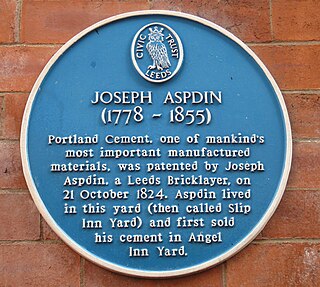Related Research Articles

A cement is a binder, a chemical substance used for construction that sets, hardens, and adheres to other materials to bind them together. Cement is seldom used on its own, but rather to bind sand and gravel (aggregate) together. Cement mixed with fine aggregate produces mortar for masonry, or with sand and gravel, produces concrete. Concrete is the most widely used material in existence and is behind only water as the planet's most-consumed resource.
Major innovations in materials technology

Calcium oxide, commonly known as quicklime or burnt lime, is a widely used chemical compound. It is a white, caustic, alkaline, crystalline solid at room temperature. The broadly used term lime connotes calcium-containing inorganic compounds, in which carbonates, oxides, and hydroxides of calcium, silicon, magnesium, aluminium, and iron predominate. By contrast, quicklime specifically applies to the single compound calcium oxide. Calcium oxide that survives processing without reacting in building products, such as cement, is called free lime.

Mortar is a workable paste which hardens to bind building blocks such as stones, bricks, and concrete masonry units, to fill and seal the irregular gaps between them, spread the weight of them evenly, and sometimes to add decorative colours or patterns to masonry walls. In its broadest sense, mortar includes pitch, asphalt, and soft clay, as those used between bricks, as well as cement mortar. The word "mortar" comes from the Old French word mortier, "builder's mortar, plaster; bowl for mixing." (13c.).

Plaster is a building material used for the protective or decorative coating of walls and ceilings and for moulding and casting decorative elements. In English, "plaster" usually means a material used for the interiors of buildings, while "render" commonly refers to external applications. The term stucco refers to plasterwork that is worked in some way to produce relief decoration, rather than flat surfaces.

Building material is material used for construction. Many naturally occurring substances, such as clay, rocks, sand, wood, and even twigs and leaves, have been used to construct buildings and other structures, like bridges. Apart from naturally occurring materials, many man-made products are in use, some more and some less synthetic. The manufacturing of building materials is an established industry in many countries and the use of these materials is typically segmented into specific specialty trades, such as carpentry, insulation, plumbing, and roofing work. They provide the make-up of habitats and structures including homes.

Joseph Aspdin was an English bricklayer, businessman, inventor, and stonemason who obtained the patent for Portland cement on 21 October 1824.

Sealing wax is a wax material of a seal which, after melting, hardens quickly, forming a bond that is difficult to break without noticeable tampering. Wax is used to verify that something such as a document is unopened, to verify the sender's identity, and as decoration. Sealing wax can also be used to take impressions of other seals. Wax was used to seal letters close and later, from about the 16th century, envelopes. Long before sealing wax was employed, the Romans used bitumen for this purpose.

Stucco or render is a construction material made of aggregates, a binder, and water. Stucco is applied wet and hardens to a very dense solid. It is used as a decorative coating for walls and ceilings, exterior walls, and as a sculptural and artistic material in architecture. Stucco can be applied on construction materials such as metal, expanded metal lath, concrete, cinder block, or clay brick and adobe for decorative and structural purposes.

Ferrocement or ferro-cement is a system of construction using reinforced mortar or plaster applied over an "armature" of metal mesh, woven, expanded metal, or metal-fibers, and closely spaced thin steel rods such as rebar. The metal commonly used is iron or some type of steel, and the mesh is made with wire with a diameter between 0.5 mm and 1 mm. The cement is typically a very rich mix of sand and cement in a 3:1 ratio; when used for making boards, no gravel is used, so that the material is not concrete.

Tadelakt is a waterproof plaster surface used in Moroccan architecture to make baths, sinks, water vessels, interior and exterior walls, ceilings, roofs, and floors. It is made from lime plaster, which is rammed, polished, and treated with soap to make it waterproof and water-repellent. Tadelakt is labour-intensive to install, but durable. Since it is applied as a paste, tadelakt has a soft, undulating character, it can form curves, and it is seamless. Pigment can be added to give it any colour, but deep red is traditional. It may have a shiny or matte finish.

Gypsum concrete is a building material used as a floor underlayment used in wood-frame and concrete construction for fire ratings, sound reduction, radiant heating, and floor leveling. It is a mixture of gypsum plaster, Portland cement, and sand.

Lime plaster is a type of plaster composed of sand, water, and lime, usually non-hydraulic hydrated lime. Ancient lime plaster often contained horse hair for reinforcement and pozzolan additives to reduce the working time.

Plasterwork is construction or ornamentation done with plaster, such as a layer of plaster on an interior or exterior wall structure, or plaster decorative moldings on ceilings or walls. This is also sometimes called pargeting. The process of creating plasterwork, called plastering or rendering, has been used in building construction for centuries. For the art history of three-dimensional plaster, see stucco.

Fireproofing is rendering something resistant to fire, or incombustible; or material for use in making anything fire-proof. It is a passive fire protection measure. "Fireproof" or "fireproofing" can be used as a noun, verb or adjective; it may be hyphenated ("fire-proof").

A plasterer is a tradesman who works with plaster, such as forming a layer of plaster on an interior wall or plaster decorative moldings on ceilings or walls. The process of creating plasterwork, called plastering, has been used in building construction for centuries. A plasterer is someone who does a full 4 or 2 years apprenticeship to be fully qualified.

A concrete pump is a machine used for transferring liquid concrete by pumping. There are different types of concrete pumps.

William Aspdin was an English cement manufacturer, and a pioneer of the Portland cement industry. He is considered the inventor of "modern" Portland cement. He has also been termed "an incorrigible liar and swindler".
James Frost (1780?-1840?) was an English businessman and inventor who invented processes that led to the eventual development of Portland cement.
Richard Wynn Keene is mainly remembered today under his theatrical name of Dykwynkyn. Keene was a Victorian designer of costumes, props, mechanical effects and scenery for plays and pantomimes on the London stage, with a strong sense of wit and a special feeling for animals. He contributed some notable props for the first cycle of Wagner's Ring at Bayreuth. He was also an artist and in his earlier career a manufacturer and inventor of building materials. Keene's cement, a type of hard plaster for internal use, perpetuates his name. Keene achieved his theatrical distinction despite being severely deaf. Probably for that reason he was never a public figure, and he died in penury.
References
- ↑ Curl, James Stevens; Wilson, Susan (2016). Oxford Dictionary of Architecture. Oxford University Press. p. 407. ISBN 978-0-19-967499-2.
- ↑ The Repertory of Patent Inventions, new series, vol. 10, June–December 1838, pp. 229–232.